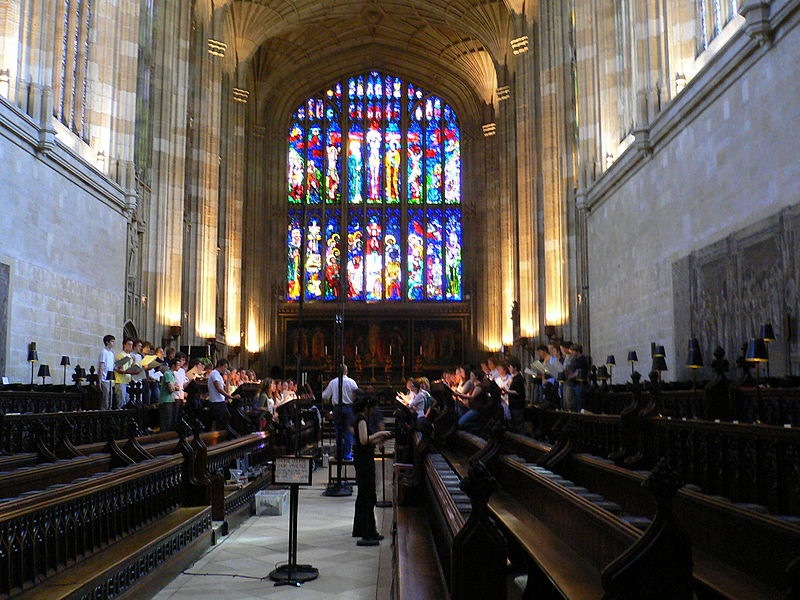
There was an in-joke among English choristers in the late 15th century: “The French sing, Italians shake, Germans wail and the Enlish rejoice” (Galli cantant, Italiae capriant, Germani ululant, Anglici jublilant, in the original Latin).
The national slurs are silly, of course, but it’s pretty much impossible not to reach a state of bliss after listening to a new album featuring seven pieces chosen by English a capella choir Tonus Peregrinus from the Eton Choirbook, one of the rare sources of English sacred music from the closing decades of the 1400s.
- Classical Music 101: What Does A Conductor Do? - June 17, 2019
- Classical Music 101 | What Does Period Instrument Mean? - May 6, 2019
- CLASSICAL MUSIC 101 | What Does It Mean To Be In Tune? - April 23, 2019

This slice of music history is particularly valuable because most manuscripts of sacred music predating King Henry VIII’s split with the Roman Catholic church were lost in the ensuing dissolution and pillaging of monasteries and their libraries in the mid-16th century — scarcely more than a century after Henry VI founded the college for underprivileged boys (pretty much the opposite of what it is now).
Written out in multicoloured inks on parchment and bound in calfskin, the Choirbook is large enough so that seven men and 10 boys would have been able to stand around it and read the music by candlelight.

Centuries and countless accidents have reduced the original 224 pages to 126, most of them written out by the same hand around 1490. The way the music is written takes learning and practice, as there are no bar lines and the choral parts don’t line up the way they do in modern notation.
But what is intelligible is a window on a polyphonic musical cosmos distinct from what was being created on the far side of the English Channel.
Composer Antony Pitts, who founded Tonus Peregrinus 22 years ago, has has worked with this music (from both sides of the watery divide) for so long that he and the choir have taken liberties in changing some notes to make music that sounds better.
Or, as Pitts explains, to help “once pallid polyphony burst into resonant combinations of tones that match the vivid blues, golds and greens of the Choirbook itself.”
 Tonus Peregrinus, recorded at a church in London, used specially constructed microphones to try and bring high-definition clarity to the long lines of undulating, intertwined voices. The result is particularly vivid, highlighting the character of individual voices, and making the Latin texts perfectly intelligible.
Tonus Peregrinus, recorded at a church in London, used specially constructed microphones to try and bring high-definition clarity to the long lines of undulating, intertwined voices. The result is particularly vivid, highlighting the character of individual voices, and making the Latin texts perfectly intelligible.
One of the most striking works on the album is a 20-minute fragment of the St Matthew Passion, as set by Richard Davy around 1500. It alternates chant with choral responses in rich polyphony that follows the drama of the story far more closely than is typical of this style of music.
A fascinating treat is the final piece, a 13-part canon by Robert Wylkynson that is a later (circa 1510) addition to the Choirbook. It starts with the words “Jesus walked among them” before the Apostles’ Creed. Because of the piece’s structure, it really sounds is as if a figure singing through every voice in the choir. It’s pure magic.
There are many ways to enjoy the music on this album, ranging from richly flecked sonic wallpaper, to blot-out-the-world meditation aid, to full-on revel in the strange and wonderful ways that repeating melodic lines and simple leaps of thirds and fifths can be made to invoke a higher spiritual plane.
For all the details on this Naxos album, the excellent booklet notes by Pitts, as well as sound samples, click here.
+++
Here to give an idea of what to expect are Harry Christophers and The Sixteen singing a Good Friday motet by John Browne from the Eton Choirbook (the Tonus Peregrinus album contains Browne’s setting of the Stabat Mater, and has a much clearer and more direct sound that is still nice and spacious.)
John Terauds
- Classical Music 101: What Does A Conductor Do? - June 17, 2019
- Classical Music 101 | What Does Period Instrument Mean? - May 6, 2019
- CLASSICAL MUSIC 101 | What Does It Mean To Be In Tune? - April 23, 2019



